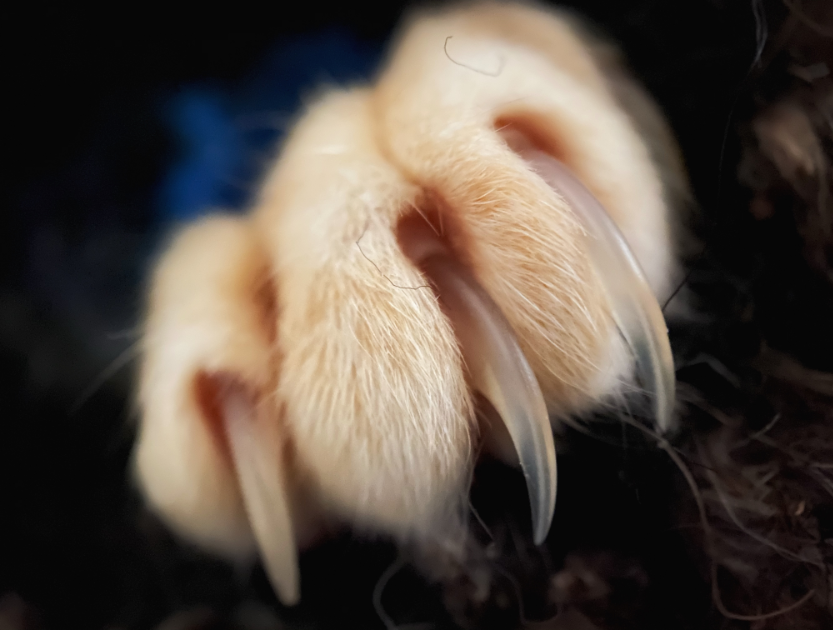Nature feels different when you can actually look it in the eyes.
For more than two years, photographer Tim Flach has been capturing images of rare, threatened, and endangered animals.
Many of Flach's photos were purposefully framed to resemble portraits of humans, focusing in on the animals' faces. The effect is striking — there's a lot of great nature photography out there, but seeing an eagle from a distance and getting to make eye contact are two very different experiences.
Giant pandas live in bamboo forests in China. It's estimated there are just over 1,800 left in the wild. Photo from Tim Flach/Tim Flach Photography Ltd./Abrams, used with permission.
After all, there's some frisson about looking into someone's eyes — a small thrill, or fear, or excitement that comes from the sudden intimacy.
Capturing that frisson wasn't always easy, though. Some shots were taken in nature preserves or zoos, but Flach also travelled the world to find his subjects — including the wobbly-nosed saiga below.
The saiga's ridiculous nose might help filter and warm the cold air it breathes. Photo from Tim Flach/Tim Flach Photography Ltd./Abrams, used with permission.
Saiga are wild antelope that live near the Caspian Sea, where locals hunt them down on mopeds. In order to get their portrait, Flach originally had travelled to the region in the summer, but the weather ended up being so hot, it actually distorted his pictures of the rare antelope. He had to go back during the (equally harsh) winter to get the shot.
Flach has now turned his project into a book, "Endangered," which was published by Abrams and is available online. If you want to see more of Flach's portraits, check out 21 more of them below:
1. Axolotl
Axolotl hail from Mexico and, unlike most salamanders, keep their gills their entire lives. Photo from Tim Flach/Tim Flach Photography Ltd./Abrams, used with permission.
2. Beluga sturgeon
Demand for beluga caviar has led to heavy fishing of this massive fish. Photo from Tim Flach/Tim Flach Photography Ltd./Abrams, used with permission.
3. Bengal tiger
Bengal tigers are some of the biggest wild cats in the world. Fewer than 2,500 may still live in the wild. Photo from Tim Flach/Tim Flach Photography Ltd./Abrams, used with permission.
4. Blue-throated macaw
Blue-throated macaws live in Bolivia and are threatened by the illegal pet trade. Photo from Tim Flach/Tim Flach Photography Ltd./Abrams, used with permission.
5. Chimpanzee
Chimpanzees are some of humanity's closest living animal relatives. Photo from Tim Flach/Tim Flach Photography Ltd./Abrams, used with permission.
6. Crowned sifaka lemur
Sifakas, like all lemurs, are endemic to Madagascar. Photo from Tim Flach/Tim Flach Photography Ltd./Abrams, used with permission.
7. Golden snub-nosed monkey
These monkeys live in central and southwest China. Photo from Tim Flach/Tim Flach Photography Ltd./Abrams, used with permission.
8. Iberian lynx
There used to be less than 100 of these rare wild cats, but thanks to conservation efforts, their numbers are rebounding. Photo from Tim Flach/Tim Flach Photography Ltd./Abrams, used with permission.
9. Gharial
Gharials are related to crocodiles and live around India and Pakistan. Photo from Tim Flach/Tim Flach Photography Ltd./Abrams, used with permission.
10. Lemur leaf frog
Lemur leaf frogs are natives to Central and South America and threatened by habitat loss and fungus. Photo from Tim Flach/Tim Flach Photography Ltd./Abrams, used with permission.
11. Mandrill
Mandrills are the world's largest monkey and live in Central Africa. Photo from Tim Flach/Tim Flach Photography Ltd./Abrams, used with permission.
12. Northern white rhino
Northern white rhinos are some of the rarest animals on Earth. As of this writing, only three may remain. Photo from Tim Flach/Tim Flach Photography Ltd./Abrams, used with permission.
13. Philippines eagle
One of the largest eagles in the world, the Phillipine eagle is known for eating monkeys. Photo from Tim Flach/Tim Flach Photography Ltd./Abrams, used with permission.
14. Pied tamarin

15. Proboscis monkey
Hahaha, look at that schnoz. Photo from Tim Flach/Tim Flach Photography Ltd./Abrams, used with permission.
16. Ring-tailed lemur
Ring-tailed lemurs are some of Madagascar's most recognizable denizens. Photo from Tim Flach/Tim Flach Photography Ltd./Abrams, used with permission.
17. Sea angels
Though these sea angels might look like little airplanes, they are, in fact, a kind of free-swimming slug. Photo from Tim Flach/Tim Flach Photography Ltd./Abrams, used with permission.
18. Shoebill
Shoebills live in eastern Africa and are kind of intimidating, if I'm being honest. Photo from Tim Flach/Tim Flach Photography Ltd./Abrams, used with permission.
19. Snow leopard
Snow leopards live high in the Himalayas and are famous for their stealth and jumping ability. Photo from Tim Flach/Tim Flach Photography Ltd./Abrams, used with permission.
20. Western lowland gorilla
The Western Lowland Gorilla's scientific name is Gorilla gorilla gorilla. That's awesome. Photo from Tim Flach/Tim Flach Photography Ltd./Abrams, used with permission.
21. White-bellied pangolin
Pangolins are some of the most trafficked animals in the world. Photo from Tim Flach/Tim Flach Photography Ltd./Abrams, used with permission.
Flach hopes that by framing these rare and endangered animals in this way, it can help people reconnect with nature.
We come from the natural world and depend on it. As our lives become more digital and removed, we need a way to reconnect to the other animals that share the planet with us.
"The most important message is that it’s not simply images of animals but that every aspect of our being is influenced by the natural world around us," Flach told The Guardian.
If you want to see more of Flach's work, follow his Instagram, Facebook, or Twitter, or visit his website. His book, "Endangered," is available from the publisher's website.




 Beaver on riverbank.
Beaver on riverbank.  Pbs Nature Swimming GIF by Nature on PBS
Pbs Nature Swimming GIF by Nature on PBS  An actual beaver dam on the now-thriving Price River
An actual beaver dam on the now-thriving Price River 
 Who doesn't love Pluto?
Who doesn't love Pluto?  Pluto agrees.
Pluto agrees. 
 a piece of paper with a heart drawn on it Photo by
a piece of paper with a heart drawn on it Photo by 
 "Bought an espresso machine, took some time to learn how to dial it in and pull a proper shot."
"Bought an espresso machine, took some time to learn how to dial it in and pull a proper shot." "Frozen meals are just as unhealthy, but much cheaper."
"Frozen meals are just as unhealthy, but much cheaper." "I’ve embraced the gray!"
"I’ve embraced the gray!"  "Bidet toilet seat is cheap, easy to install, much easier and faster to use."
"Bidet toilet seat is cheap, easy to install, much easier and faster to use."
 American portion sizes are colossal.Canva Photos
American portion sizes are colossal.Canva Photos American public restrooms aren't very private.Canva Photos
American public restrooms aren't very private.Canva Photos Cashiers in America stand all shift long.Canva Photos
Cashiers in America stand all shift long.Canva Photos America loves the Pledge of Allegiance.Canva Photos.
America loves the Pledge of Allegiance.Canva Photos. Cosmetic surgeries on pets are...a choice.Canva Photos.
Cosmetic surgeries on pets are...a choice.Canva Photos. America loves extra sugar in savory foods.Canva Photos.
America loves extra sugar in savory foods.Canva Photos.